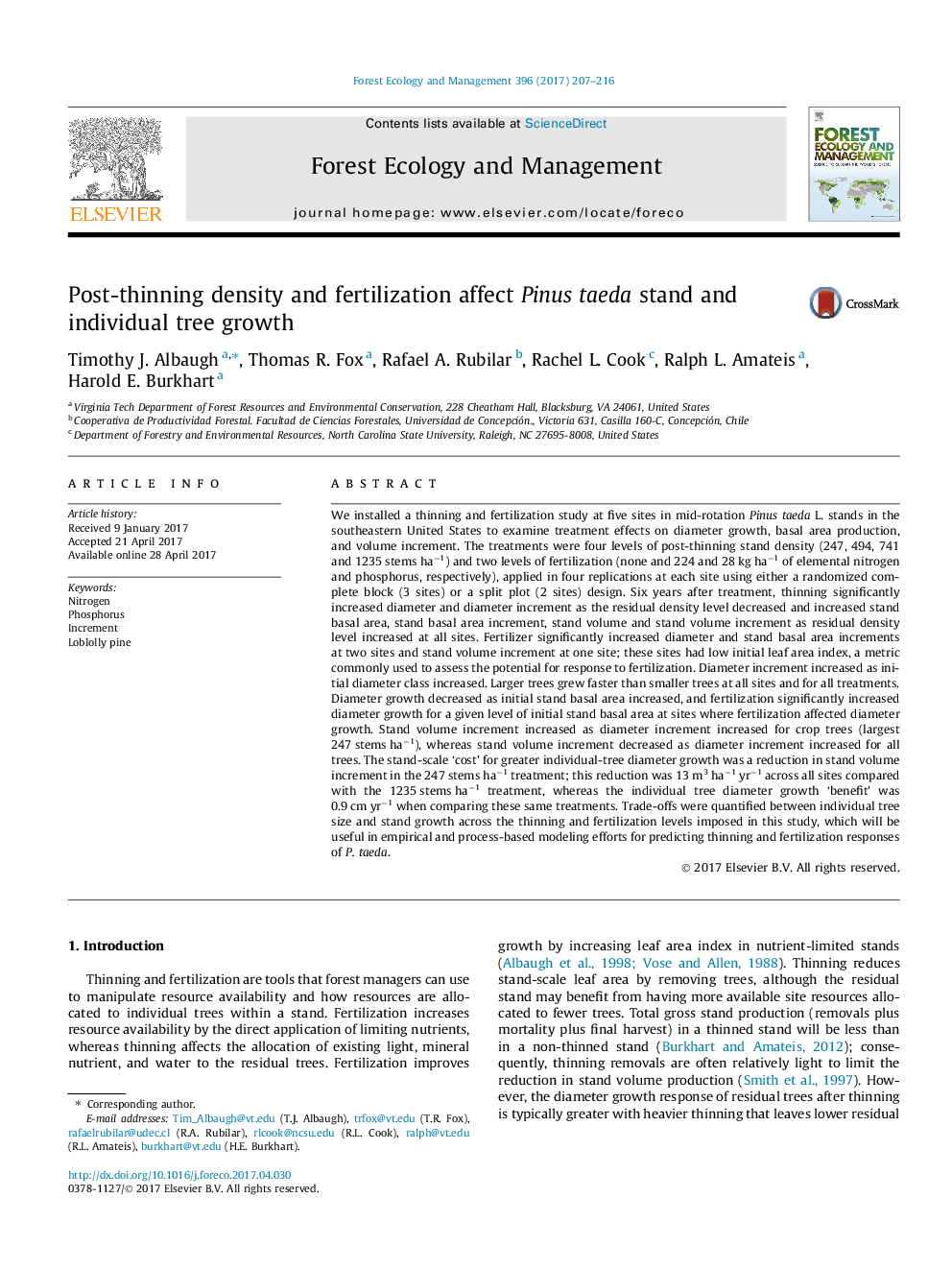| کد مقاله | کد نشریه | سال انتشار | مقاله انگلیسی | نسخه تمام متن |
|---|---|---|---|---|
| 4759430 | 1421362 | 2017 | 10 صفحه PDF | دانلود رایگان |
عنوان انگلیسی مقاله ISI
Post-thinning density and fertilization affect Pinus taeda stand and individual tree growth
ترجمه فارسی عنوان
تراکم پس از ریختن و بارور شدن باعث افزایش رشد و تکثیر درخت پنسوس تداعی می شود
دانلود مقاله + سفارش ترجمه
دانلود مقاله ISI انگلیسی
رایگان برای ایرانیان
موضوعات مرتبط
علوم زیستی و بیوفناوری
علوم کشاورزی و بیولوژیک
بوم شناسی، تکامل، رفتار و سامانه شناسی
چکیده انگلیسی
We installed a thinning and fertilization study at five sites in mid-rotation Pinus taeda L. stands in the southeastern United States to examine treatment effects on diameter growth, basal area production, and volume increment. The treatments were four levels of post-thinning stand density (247, 494, 741 and 1235 stems haâ1) and two levels of fertilization (none and 224 and 28 kg haâ1 of elemental nitrogen and phosphorus, respectively), applied in four replications at each site using either a randomized complete block (3 sites) or a split plot (2 sites) design. Six years after treatment, thinning significantly increased diameter and diameter increment as the residual density level decreased and increased stand basal area, stand basal area increment, stand volume and stand volume increment as residual density level increased at all sites. Fertilizer significantly increased diameter and stand basal area increments at two sites and stand volume increment at one site; these sites had low initial leaf area index, a metric commonly used to assess the potential for response to fertilization. Diameter increment increased as initial diameter class increased. Larger trees grew faster than smaller trees at all sites and for all treatments. Diameter growth decreased as initial stand basal area increased, and fertilization significantly increased diameter growth for a given level of initial stand basal area at sites where fertilization affected diameter growth. Stand volume increment increased as diameter increment increased for crop trees (largest 247 stems haâ1), whereas stand volume increment decreased as diameter increment increased for all trees. The stand-scale 'cost' for greater individual-tree diameter growth was a reduction in stand volume increment in the 247 stems haâ1 treatment; this reduction was 13 m3 haâ1 yrâ1 across all sites compared with the 1235 stems haâ1 treatment, whereas the individual tree diameter growth 'benefit' was 0.9 cm yrâ1 when comparing these same treatments. Trade-offs were quantified between individual tree size and stand growth across the thinning and fertilization levels imposed in this study, which will be useful in empirical and process-based modeling efforts for predicting thinning and fertilization responses of P. taeda.
ناشر
Database: Elsevier - ScienceDirect (ساینس دایرکت)
Journal: Forest Ecology and Management - Volume 396, 15 July 2017, Pages 207-216
Journal: Forest Ecology and Management - Volume 396, 15 July 2017, Pages 207-216
نویسندگان
Timothy J. Albaugh, Thomas R. Fox, Rafael A. Rubilar, Rachel L. Cook, Ralph L. Amateis, Harold E. Burkhart,
